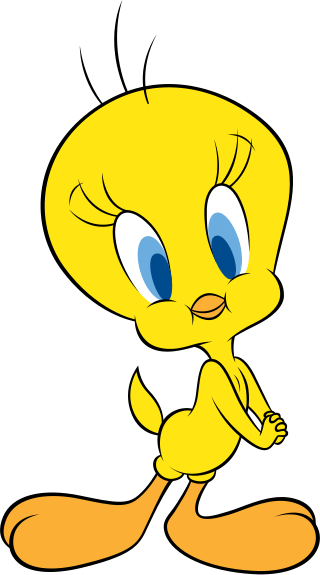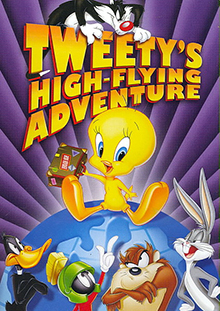
Looney Tunes is an American animated franchise produced and distributed by Warner Bros. It began as a series of short films that originally ran from 1930 to 1969, along with its spin-off series Merrie Melodies, during the golden age of American animation. Following a revival in the late 1970s, new shorts were released as recently as 2014. The two series introduced a large cast of characters, including Bugs Bunny, Daffy Duck, and Porky Pig. The term Looney Tunes has since been expanded to also refer to the characters themselves.

Daffy Duck is a cartoon character created by animators Tex Avery and Bob Clampett for Leon Schlesinger Productions. Styled as an anthropomorphic black duck, he has appeared in cartoon series such as Looney Tunes and Merrie Melodies, in which he is usually depicted as a foil for either Bugs Bunny, Porky Pig or Speedy Gonzales. He was one of the first of the new "screwball" characters that emerged in the late 1930s to replace traditional everyman characters who were more popular earlier in the decade, such as Mickey Mouse, Porky Pig, and Popeye.

Tweety is a yellow canary in the Warner Bros. Looney Tunes and Merrie Melodies series of animated cartoons. His characteristics are based on Red Skelton's famous "Junior the Mean Widdle Kid." He appeared in 46 cartoons during the golden age, made between 1942 and 1964.

Sylvester J. Pussycat Sr. is a fictional character, an anthropomorphic cat in the Looney Tunes and Merrie Melodies series of cartoons. Most of his appearances have him often chasing Tweety Bird, Speedy Gonzales, or Hippety Hopper. He appeared in 103 cartoons in the golden age of American animation, lagging only behind superstars Bugs Bunny, Porky Pig, and Daffy Duck. Three of his cartoons won Academy Awards, the most for any starring a Looney Tunes character: they are Tweetie Pie, Speedy Gonzales, and Birds Anonymous.

Tiny Toon Adventures is an American animated television series created by Tom Ruegger that was broadcast from September 14, 1990, to December 6, 1992. It was the first animated series produced by Steven Spielberg's Amblin Television in association with Warner Bros. Animation. The show follows the adventures of a group of young cartoon characters who attend Acme Looniversity to become the next generation of characters from the Looney Tunes series.

Robert Porter McKimson Sr. was an American animator and illustrator, best known for his work on the Looney Tunes and Merrie Melodies series of cartoons from Warner Bros. Cartoons and later DePatie–Freleng Enterprises. He wrote and directed many animated cartoon shorts starring Bugs Bunny, Daffy Duck, Porky Pig, Foghorn Leghorn, Hippety Hopper, Speedy Gonzales, and the Tasmanian Devil, among other characters. He also developed Bugs Bunny's design in the 1943 short Tortoise Wins by a Hare.

The Tasmanian Devil, commonly referred to as Taz, is an animated cartoon character featured in the Warner Bros. Looney Tunes and Merrie Melodies series of cartoons. Though the character appeared in only five shorts before Warner Bros. Cartoons shut down in 1964, marketing and television appearances later propelled Taz to new popularity in the 1990s.

Granny, whose full name is presented as Emma Webster, is a fictional character created by Friz Freleng, best known from the Looney Tunes and Merrie Melodies animated short films of the 1950s and 1960s. She is the owner of Tweety Bird and, more often than not, Sylvester and Hector. Her voice was first provided by Bea Benaderet from 1950 through 1955, then by June Foray for almost 60 years then Candi Milo took over in 2017 following Foray's death.
Warner Bros. Cartoons, Inc. was an American animation studio, serving as the in-house animation division of Warner Bros. during the Golden Age of American animation. One of the most successful animation studios in American media history, it was primarily responsible for the Looney Tunes and Merrie Melodies series of animated short films. The characters featured in these cartoons, including Bugs Bunny, Daffy Duck, and Porky Pig, are among the most famous and recognizable characters in the world. Many of the creative staff members at the studio, including directors and animators such as Chuck Jones, Friz Freleng, Robert McKimson, Tex Avery, Robert Clampett, Arthur Davis, and Frank Tashlin, are considered major figures in the art and history of traditional animation.

The Sylvester & Tweety Mysteries is an American animated television series produced by Warner Bros. Television Animation which aired from September 9, 1995 to February 5, 2000 on Kids' WB. The final episode, containing the segments "The Tail End?" and "This Is the End", was never shown on Kids' WB, not premiering until December 18, 2002, when the show aired in reruns on Cartoon Network. 52 episodes were produced.

Merlin the Magic Mouse is an animated cartoon mouse, who starred in five Warner Bros. Looney Tunes shorts late in the series, from 1967 to 1969. The first cartoon was Merlin the Magic Mouse, directed by Alex Lovy.
Colonel Shuffle is a fictional character in the Looney Tunes stable, based in the Southern United States.

Tweety's High-Flying Adventure is a 2000 American animated musical slapstick comedy film produced by Tom Minton and James T. Walker, written by Tom Minton, Tim Cahill and Julie McNally, and directed by James T. Walker, Karl Toerge, Charles Visser, and Kyung Won Lim, starring Tweety.

Beaky Buzzard is an animated cartoon character in the Warner Bros. Looney Tunes and Merrie Melodies series of cartoons.

Foghorn Leghorn is an anthropomorphic rooster who appears in Looney Tunes and Merrie Melodies cartoons and films from Warner Bros. Animation. He was created by Robert McKimson, and starred in 29 cartoons from 1946 to 1964 in the golden age of American animation. All 29 of these cartoons were directed by McKimson.
This is a listing of all the animated shorts released by Warner Bros. under the Looney Tunes and Merrie Melodies banners between 1960 and 1969. A total of 147 shorts were released during the 1960s.













